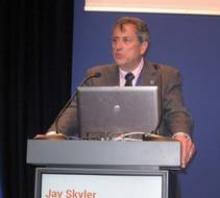BERLIN – Bolus, mealtime dosages of a new formulation of insulin paired with recombinant human hyaluronidase to speed insulin’s absorption and action led to significantly reduced postprandial, glycemic excursions in a randomized study of 113 patients with type 1 diabetes.
The hyaluronidase plus insulin formulation also resulted in a "flatter" daytime glucose profile, and led to a statistically significant reduction in hypoglycemic events, Dr. Jay S. Skyler said at the annual meeting of the European Association for the Study of Diabetes. In addition to these improvements in insulin management, the study results also showed that the hyaluronidase formulation was noninferior to insulin alone for reducing hemoglobin A1c levels, and also had a similar safety and tolerability profile in type 1 patients, said Dr. Skyler, professor and deputy director of the diabetes research institute of the University of Miami.
"This is not the first report on hyaluronidase, but it’s very exciting. The results are pretty amazing," commented Dr. John L. Leahy, professor and codirector of the division of endocrinology, diabetes, and metabolism at the University of Vermont in Colchester. "Postprandial control really improved, and safety didn’t seem to change. There are different approaches that companies are taking to try to create superfast insulin; hyaluronidase is one approach. The main limitation is that these are studies of modest duration," 12 weeks in this study, Dr. Leahy noted in an interview. "You don’t know what it means when patients are shooting hyaluronidase over the course of 2 years, so we need more experience with longer duration. But I thought these were powerful data."
The study, done at 18 sites, enrolled patients with type 1 diabetes (average age, 43) who had an average hemoglobin A1c of 7.43 and were maintained on a basal/bolus regimen.
After a 4- to 6-week run-in period on an open-label bolus with insulin glulisine and a twice-daily basal insulin dosage with glargine, Dr. Skyler and his associates randomized 117 patients to bolus treatment with either of two forms of 100 U/mL insulin – either insulin aspart or lispro – plus 5 g/mL recombinant human hyaluronidase, or to treatment with insulin lispro 100 U/mL alone for 12 weeks. Following the first 12-week period, patients were crossed either off of or onto the hyaluronidase-containing formulation for a second 12-week treatment period. Throughout the study, patients remained on their twice-daily glargine basal regimen. Four patients failed to complete the study, which left 113 patients available for outcomes analysis.
"When you use a very rapidly acting insulin, you need to be sure that the basal insulin level is correct. The protocol was written to treat all patients with glargine insulin twice daily so that patients would have a constant, steady basal insulinemia," Dr. Skyler said.
The average hemoglobin A1c was about 6.8% in both treatment arms after 12 weeks, which met the study’s prespecified end point for noninferiority for the hyaluronidase formulations.
The incidence of postprandial glycemic excursions throughout the day was 82% lower in patients treated with hyaluronidase formulations than in those who received insulin-only bolus injections, a statistically significant difference. The incidence of total hypoglycemic events was also significantly lower in the hyaluronidase-treated patients; severe hypoglycemic episodes occurred in one patient who received hyaluronidase plus insulin aspart or lispro, and in five who received bolus insulin lispro only.
Commenting on the apparent disconnect between the reduced number of glycemic excursions in the hyaluronidase-treated patients without an improvement in hemoglobin A1c levels, Dr. Skyler noted that the time on the hyaluronidase formulation was brief, just 12 weeks. "This may not have been enough time" to see an effect on A1c, he said.
The two treatment arms also showed no differences in the incidence of adverse events, serious adverse events, immunogenicity of the drugs, or injection-site pain.
Now that these results have documented the superior efficacy of hyaluronidase formulations, the next step is to better optimize the dosing algorithms for hyaluronidase-containing insulin formulations, Dr. Skyler said.
The study was sponsored by Halozyme Therapeutics, the company that is developing the hyaluronidase and insulin formulation. Dr. Skyler said his university has received grant support from Halozyme. He said that he has had relationships with several drug companies, as an adviser, consultant, a member of the board of directors, or a shareholder. Dr. Leahy said he has been an adviser to Novo Nordisk, Merck, and Sanofi-Aventis.



